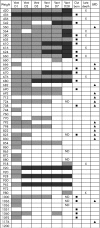Sustainable use of continuous positive airway pressure in extremely preterm infants during the first week after delivery
- PMID: 16820391
- PMCID: PMC2672749
- DOI: 10.1136/adc.2005.092478
Sustainable use of continuous positive airway pressure in extremely preterm infants during the first week after delivery
Erratum in
- Arch Dis Child Fetal Neonatal Ed. 2008 Jan;93(1):F78
Abstract
Background: Early use of nasal continuous positive airway pressure (nCPAP) may reduce lung damage, but it is not clear how many extremely preterm infants can be cared for without mechanical ventilation on the first days after delivery.
Objectives: To describe our experience of nCPAP in infants born at <27 weeks' gestation and to determine the chance of reintubation of this group of extremely preterm infants.
Methods: A retrospective, observational study examined the period from November 2002 to October 2003, when efforts were made to extubate infants to nCPAP at the earliest opportunity. Data were collected on all infants born at <27 weeks' and gestation admitted to The Neonatal Intensive Care Unit, Queen Charlotte's and Chelsea Hospital, London, UK. The chance of an individual infant requiring reintubation within 48 h of delivery was estimated, calculating the predictive probability using a Bayesian approach, and oxygen requirements at 36 weeks' postmenstrual age were examined.
Results: 60 infants, 34 inborn and 26 ex utero transfers, were admitted; 7 infants admitted 24 h after birth were excluded and 5 died within 48 h. The mean birth weight was 788 g and the gestational age was 25.3 weeks. Extubation was attempted on day 1 in 21 of 52 infants on ventilators and was successful in 14; and on day 2 in 14 of 35 and successful in 10 of infants extubated within 48 h of delivery survived to discharge. 5 of 23 infants on mechanical ventilation at 48 h of age were on air at 36 weeks postmenstrual age, and 12 of 26 of those were on nCPAP at 48 h of age. The probability of an individual baby remaining on nCPAP was 66% (95% CI 46% to 86%) on day 1 and 80% (95% CI 60% to 99%) on day 2. The smallest infant to be successfully extubated was 660 g and the youngest gestational age was 23.8 weeks.
Conclusions: Extremely preterm infants can be extubated to nCPAP soon after delivery, with a reasonable probability of not requiring immediate reintubation.
Conflict of interest statement
Competing interests: None declared.
Comment in
-
To intubate or not--that is the question: continuous positive airway pressure versus surfactant and extremely low birthweight infants.Arch Dis Child Fetal Neonatal Ed. 2006 Nov;91(6):F392-4. doi: 10.1136/adc.2006.099754. Arch Dis Child Fetal Neonatal Ed. 2006. PMID: 17056836 Free PMC article.
Similar articles
-
Very early surfactant without mandatory ventilation in premature infants treated with early continuous positive airway pressure: a randomized, controlled trial.Pediatrics. 2009 Jan;123(1):137-42. doi: 10.1542/peds.2007-3501. Pediatrics. 2009. PMID: 19117872 Clinical Trial.
-
Nasal intermittent positive pressure ventilation after surfactant treatment for respiratory distress syndrome in preterm infants <30 weeks' gestation: a randomized, controlled trial.J Perinatol. 2012 May;32(5):336-43. doi: 10.1038/jp.2012.1. Epub 2012 Feb 2. J Perinatol. 2012. PMID: 22301528 Clinical Trial.
-
A randomized controlled trial of two nasal continuous positive airway pressure levels after extubation in preterm infants.J Pediatr. 2014 Jan;164(1):46-51. doi: 10.1016/j.jpeds.2013.08.040. Epub 2013 Oct 1. J Pediatr. 2014. PMID: 24094879 Clinical Trial.
-
CPAP and the preterm infant: lessons from the COIN trial and other studies.Early Hum Dev. 2008 Dec;84(12):791-3. doi: 10.1016/j.earlhumdev.2008.09.003. Epub 2008 Sep 19. Early Hum Dev. 2008. PMID: 18804926 Review.
-
Weaning preterm infants from continuous positive airway pressure: evidence for best practice.World J Pediatr. 2015 Aug;11(3):212-8. doi: 10.1007/s12519-015-0022-6. Epub 2015 Apr 6. World J Pediatr. 2015. PMID: 25846068 Review.
Cited by
-
Analysis and comparison of the effects of N-BiPAP and Bubble-CPAP in treatment of preterm newborns with the weight of below 1500 grams affiliated with respiratory distress syndrome: A randomised clinical trial.Adv Biomed Res. 2016 Jan 27;5:3. doi: 10.4103/2277-9175.174965. eCollection 2016. Adv Biomed Res. 2016. PMID: 26955624 Free PMC article.
-
EXTUBATE: a randomised controlled trial of nasal biphasic positive airway pressure vs. nasal continuous positive airway pressure following extubation in infants less than 30 weeks' gestation: study protocol for a randomised controlled trial.Trials. 2011 Dec 9;12:257. doi: 10.1186/1745-6215-12-257. Trials. 2011. PMID: 22152592 Free PMC article. Clinical Trial.
-
Synchronized nasal intermittent positive-pressure ventilation and neonatal outcomes.Pediatrics. 2009 Aug;124(2):517-26. doi: 10.1542/peds.2008-1302. Epub 2009 Jul 27. Pediatrics. 2009. PMID: 19651577 Free PMC article.
-
A comparison of two interventions for HHHFNC in preterm infants weighing 1,000 to 1,500 g in the recovery period of newborn RDS.Adv Biomed Res. 2014 Aug 19;3:172. doi: 10.4103/2277-9175.139188. eCollection 2014. Adv Biomed Res. 2014. PMID: 25250286 Free PMC article.
-
A pharmacoeconomic analysis of in-hospital costs resulting from reintubation in preterm infants treated with lucinactant, beractant, or poractant alfa.J Pediatr Pharmacol Ther. 2012 Jul;17(3):220-7. doi: 10.5863/1551-6776-17.3.220. J Pediatr Pharmacol Ther. 2012. PMID: 23258964 Free PMC article.
References
MeSH terms
LinkOut - more resources
Full Text Sources
Medical

